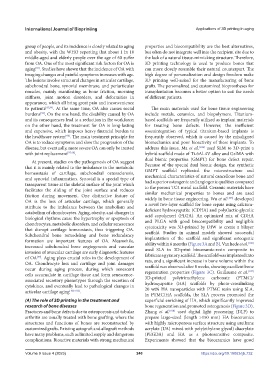Page 248 - IJB-9-4
P. 248
International Journal of Bioprinting Applications of 3D printing in aging
group of people, and its incidence is closely related to aging properties and biocompatibility are the best alternatives,
and obesity, with the WHO reporting that about 1 in 10 but often do not integrate well into the recipient site due to
middle-aged and elderly people over the age of 60 suffer the lack of a natural tissue-mimicking structure. Therefore,
from OA. One of the most significant risk factors for OA is 3D printing technology is used to produce bones that
aging . Studies have shown that the incidence of OA with can more closely resemble their natural counterpart. The
[92]
imaging changes and painful symptoms increases with age. high degree of personalization and design freedom make
The lesions involve structural changes in articular cartilage, 3D printing well-suited for the manufacturing of bone
subchondral bone, synovial membrane, and periarticular grafts. The personalized and customized bioprostheses for
muscles, mainly manifesting as bone friction, morning transplantation becomes a better option to suit the needs
stiffness, joint motion disorders, and deformities in of different patients.
appearance, which all bring great pain and inconvenience
to patients [93,94] . At the same time, OA also causes social The main materials used for bone tissue engineering
burdens . On the one hand, the disability caused by OA include metals, ceramics, and biopolymers. Titanium-
[95]
and its consequences lead to a reduction in the workforce; based scaffolds are frequently utilized as implant materials
on the other hand, the treatment for OA is long-lasting for treating bone defects. However, the inefficient
and expensive, which imposes heavy financial burden to osseointegration of typical titanium-based implants is
the healthcare system . The main treatment principle for frequently observed, which is caused by the misaligned
[96]
OA is to reduce symptoms and slow the progression of the biomechanics and poor bioactivity of these implants. To
disease, but eventually, more severe OA can only be treated address this issue, Ma et al. [104] used SLM to 3D-print a
with joint replacement [97,98] . hybrid scaffold made of Ti-6Al-4V alloy and GelMA with
At present, studies on the pathogenesis of OA suggest dual bionic properties (GMPT) for bone defect repair.
that it is mainly related to the imbalance in the metabolic Because of the special dual bionic design, the synthetic
homeostasis of cartilage, subchondral osteosclerosis, GMPT scaffold replicated the microstructure and
and synovial inflammation. Synovial is a special type of mechanical characteristics of natural cancellous bone and
transparent tissue at the skeletal surface of the joint which had superior osteogenic and angiogenic qualities compared
facilitates the sliding of the joint surface and reduces to the porous TC4 metal scaffold. Ceramic materials have
friction during movement. One distinctive feature of similar mechanical properties to bones and are used
[105]
OA is the loss of articular cartilage, which generally widely in bone tissue engineering. Wu et al. developed
attribute to the imbalance between the anabolism and a novel two-layer scaffold for bone repair using calcium-
catabolism of chondrocytes. Aging, obesity, and changes in deficient hydroxyapatite (CDHA) and poly(lactic-glycolic
biological rhythms cause the hypertrophy or apoptosis of acid copolymer) (PLGA). An optimized mix of CDHA
chondrocytes, metabolic disorders, and cellular senescence and PLGA with good biocompatibility and negligible
that disrupt cartilage homeostasis, thus triggering OA. cytotoxicity was 3D-printed by DIW to create a bilayer
Subchondral bone remodeling and bone redundancy scaffold. Studies in animal models showed successful
formation are important features of OA. Meanwhile, implantation of the scaffold and significant osteogenic
[106]
increased subchondral bone angiogenesis and vascular ability within 6 months (Figure 3A and B). Van hede et al.
invasion of avascular cartilage are early diagnostic features used SLA to 3D-print bioceramic-resin composite to
of OA . Aging plays crucial roles in the development of fabricate a gyratory scaffold. The scaffold was implanted into
[99]
OA. Chondrocyte loss and cartilage and joint damages rats, and a significant increase in bone volume within the
occur during aging process, during which senescent scaffold was observed after 8 weeks, showing excellent bone
[107]
cells accumulate in cartilage tissue and form senescence- regeneration properties (Figure 3C). Guillaume et al.
associated secretory phenotypes through the secretion of 3D-printed polytrimethylene carbonate (PTMC)/
cytokines, and eventually lead to pathological changes in hydroxyapatite (HA) scaffolds by photo-crosslinking
articular cartilage aging [100-103] . 20 wt% HA nanoparticles with PTMC resin using SLA.
In PTMC/HA scaffolds, the SLA process promoted the
(A) The role of 3D printing in the treatment and superficial enriching of HA, which significantly improved
research of bone diseases bone regeneration and promoted osteogenesis (Figure 3D).
Fractures and bone defects due to osteoporosis and tubular Zhang et al. [108] used digital light processing (DLP) to
arthritis are usually treated with bone grafting, where the prepare large-sized (length >150 mm) HA bioceramics
structures and functions of bones are reconstructed by with highly microporous surface structure using urethane
customized grafts. Existing autograft and allograft methods acrylate (UA) mixed with poly(ethylene glycol) diacrylate
have many problems, such as limited supply and dangerous (PEGDA) and HA as a photosensitive composite.
complications. Bioactive materials with strong mechanical Experiments showed that the bioceramics have good
Volume 9 Issue 4 (2023) 240 https://doi.org/10.18063/ijb.732

